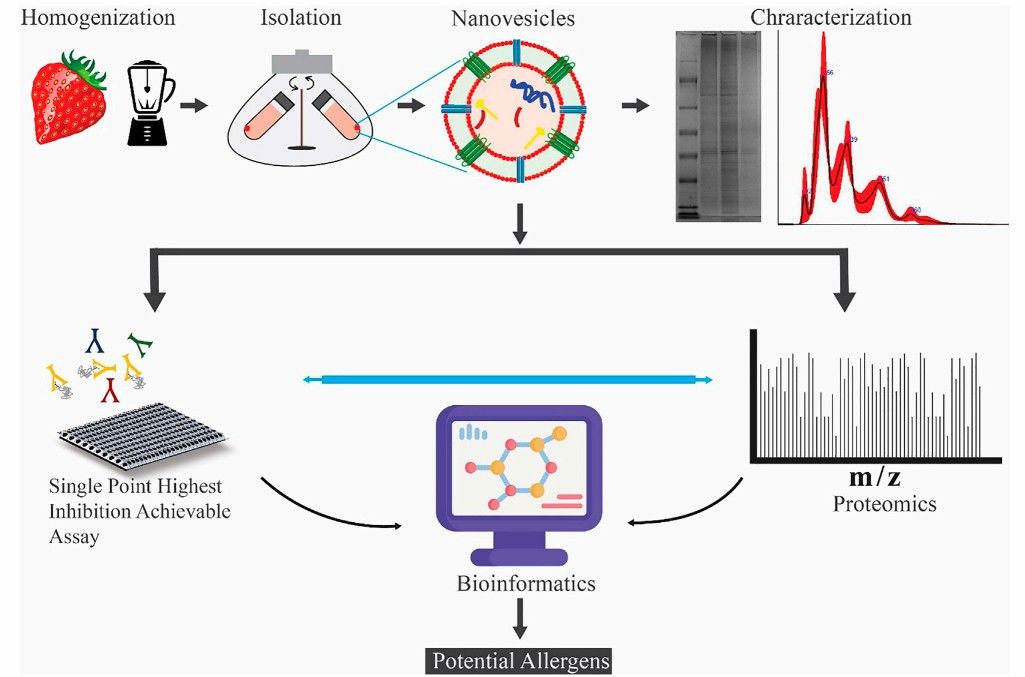Strawberry-derived Exosome Research and Application
Strawberries are recognized as one of the berries rich in nutritive and non-nutritive bioactive components and are characterized by a wide range of species and compounds. Given this, strawberry-derived exosomes have also been hypothesized to have the potential for health promotion and disease intervention. Creative Biolabs has accumulated insights involving strawberry-derived exosomes and can provide pilot research services related to exosome production and functional exploration.
Strawberry-derived Exosome Isolation and Functions
-
Pre-treatment of strawberries: washing, removal of calyxes, squeezing or crushing, and filtration to collect juice.
-
Differential centrifugation to remove impurities such as strawberry residue and cellular debris.
-
Filter the supernatant and re-centrifugation for several cycles.
-
Ultracentrifuge several times to obtain strawberry exosome precipitates.
-
Resuspend strawberry exosomes in sterile PBS.
-
Store at -80 ℃ until ready to use.
-
Serve as stable biological drug delivery systems.
-
Carrying active ingredients that can be applied in the fields of strawberry nutritional fortification, nutraceuticals, and cosmetics.
-
Applied in agriculture as plant growth promoters and plant protection agent to improve plant growth and disease resistance.
 Fig. 1 A workflow for isolating strawberry-derived exosomes.1
Fig. 1 A workflow for isolating strawberry-derived exosomes.1
Features and Research

|
Case Studies
|
|
Methods
|
Results
|
|
Transmission electron microscopy observations.
|
Strawberry-derived exosomes are similar in morphology and size to animal-derived exosomes and other plant-derived exosomes.
|
|
Fluorescence microscopy observation of PKH26-labeled exosomes accumulation in target cells at different time points.
|
Capable of being taken up by human mesenchymal stromal cells and accumulating in the cytoplasm.
|
|
Live cell staining to assess exosome toxicity.
|
Strawberry-derived exosomes did not negatively affect cell survival.
|
|
Determining exosome effects in H2O2-induced cellular oxidative stress models.
|
Strawberry-derived exosomes alleviated the H2O2 stimulation of cells and reduced ROS production at certain doses.
|
|
RNA profiling.
|
-
The presence of small RNAs in exosomes was detected, which affected the responsiveness of plants to biotic stress.
-
miR166g was detected to be enriched in strawberry-derived exosomes.
|
|
Proteomic analysis and immunological tests.
|
The identification of proteins that may be allergenic in vesicles isolated from strawberries is a point that should be taken into account when applying strawberry exosomes to biomedical vectors.
|
 Fig. 2 Schematic diagram of investigating potential allergenic proteins in strawberry-derived vesicles.2
Fig. 2 Schematic diagram of investigating potential allergenic proteins in strawberry-derived vesicles.2
Creative Biolabs, as a leading supplier of exosome services and products, has expert research insights on strawberry-derived exosomes and is capable of providing relevant customized pilot study services. Please contact us to describe your requirements.
References
-
Perut, Francesca, et al. "Strawberry-derived exosome-like nanoparticles prevent oxidative stress in human mesenchymal stromal cells." Biomolecules 11.1 (2021): 87.
-
Stanly, Christopher, et al. "Crosstalk between the immune system and plant-derived nanovesicles: A study of allergen transporting." Frontiers in Bioengineering and Biotechnology 9 (2021): 760730.
For Research Use Only. Cannot be used by patients.
Related Services:

 Fig. 1 A workflow for isolating strawberry-derived exosomes.1
Fig. 1 A workflow for isolating strawberry-derived exosomes.1

 Fig. 2 Schematic diagram of investigating potential allergenic proteins in strawberry-derived vesicles.2
Fig. 2 Schematic diagram of investigating potential allergenic proteins in strawberry-derived vesicles.2









